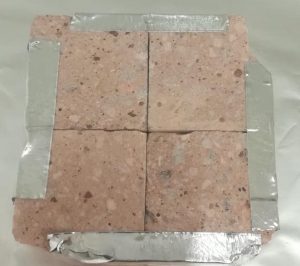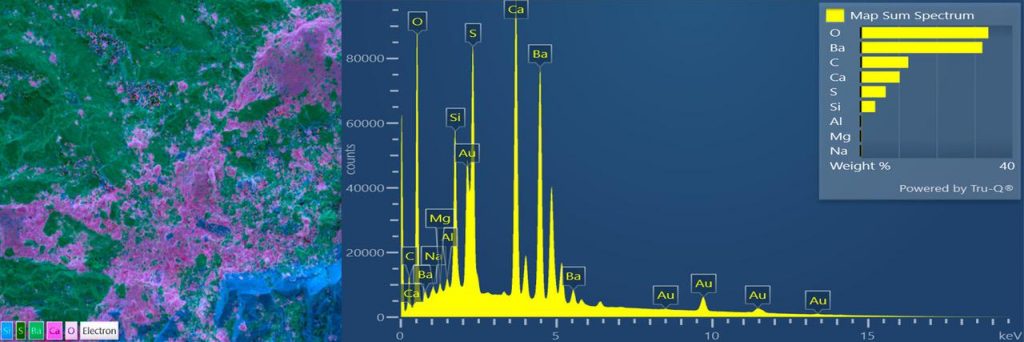A unique combination of scanning electron microscopy to look at the atomic level details of heavy concrete, and its neutron shielding properties.
Standard concrete continues to be the most utilised concrete, even when dense concrete might be considered a better, more cost-effective and time-reducing alternative. However, heavy concrete is often a better choice for radiation shielding, or when the required density is over 2600 kg/m3, or when the concrete structure needs additional weight within restricted dimensions, such as with counterweights, and coastal protection blocks.
In medical physics, installations such as cyclotrons or high energy linacs need massive shielding against neutrons and gamma rays that are produced during their operation. Therefore, materials containing heavy-weight elements, such as barites or magnetite, are often used as aggregates in the preparation of heavy-weight concrete for shielding applications. Methods and recipes to obtain heavy concrete aim at reducing wall thickness but keeping optimum protection against radiation.

By using heavy concrete up to 40% of the wall thickness can be eliminated compared to ordinary concrete. However, the concentration of barite (BaSO4) in heavy-weight concrete needs to be tuned to determine the optimal shielding properties in a mixed γ -ray and neutron radiation environment.
A unique combination of scanning electron microscopy, energy-dispersive X-ray spectroscopy and neutron transmission has been carried out to look at the atomic level details of heavy concrete, and its neutron shielding properties. In their study published in EPJ PLUS, industrial researchers from Mardel s.r.l., in collaboration with Bariblock – SVA s.r.l., worked alongside with ISIS@MACH ITALIA from Unit University of Rome Tor Vergata and ISIS scientists to carry out morphological and chemical analysis investigations, complemented by wide energy range neutron transmission on a series of barite-enriched concrete samples carried out on the VESUVIO spectrometer at ISIS UK. The determination of precise and accurate transmission spectra of concrete samples benefited of an independent and parallel set of neutron tests of GEM detectors development by the the IMI Unit Facility teams based at University of Milan Bicocca. Gabriele Croci, member of the team stressed that “the first double ceramic thick GEM detector realised were successfully commissioned on VESUVIO, using the IMI Neutron Gate, and first results are promising”.
EDS and neutron transmission measurements were thus uniquely combined, showing that the amounts of barium and hydrogen are correlated, with a lower amount of hydrogen in the samples with more barium, likely because of the absence of some calcium-silicon-hydrate structures, whose formation is inhibited by the presence of barite.

Marco Martellucci (Martel s.r.l.) said that “this investigation allows manufacturers and radiation protection designers to evaluate the optimal barite concentration to maximise mechanical properties and balanced radiation shielding”. Deep, in-bulk neutron transmission measurements carried out on the VESUVIO spectrometer at ISIS complemented the SEM-EDS results, obtaining absolute cross-section data for a range of ten different concrete densities, as a function of the barite content fraction. Enrico Preziosi ((IM@IT Unit University of Rome Tor Vergata) noticed that “spatial chemical maps at the microscopic scale enhance our understanding between the fabrication methods and the expected performances of these barium-enriched high-density concretes”. “Not only we see the correlated effects of barium and hydrogen content – commented Giovanni Romanelli (ISIS Facility)- but we can further envisage a standardisation of neutron transmission capabilities on structural materials for medical physics and reactor sciences.”
These uniquely combined studies pave the way towards a reliable characterisation of large scale structural materials used in heavy radiation environments.

Roberto Senesi (IM@IT Unit University of Rome Tor Vergata) summarised: “This powerful combination of techniques may have a clear impact in radiation protection structural design, as well as to provide an insight into the intricated chemical-physical character of special concrete fabrication methods. “
Further information:
IM@IT Unit University of Rome Tor Vergata, Mardel s.r.l., Bariblock – SVA s.r.l.






